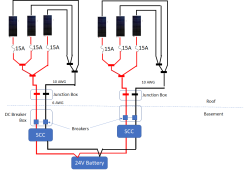If the battery negative is grounded and the SCC has a common Negative, yes. However, I don't think the NEC has a carve-out for this. (I wonder why?)
This entire exchange with you has been enormously helpful to me and I want to thank you for your engagement and insight once again.
If the Forum has an award for ‘Member of the Year’, you’d get my vote

.
I’m pretty much all set on my plan for adding 2 3P1S strings but still have some confusion in two areas I was hoping you might be able to enlighten me:
Temperature Ratings: I’m pretty sure that as long as all my roof-mounted circuit components are rated to take over my maximum current rating at over my maximum ambient temperature, I’m good to go, but the rules about derating to the temperature rating of the lowest-temperature-rated component have me a bit confused so I’d appreciate a confirmation. Here is a rundown:
Highest recorded temperature where I live is 107F / 41.7C.
15A MC4 fuse holders and fuses are rated to 125C
I can’t find a temperature rating for the 15A fuse itself but that should not be a concern since being too hot exults in the fuse blowing (not a safety concern).
Vanilla MC4 connectors rated for 30A up to 90C.
10AWG USE-2 wire freestanding in air rated for 55A up to 90C.
The first generic MC4 Y connectors for is rated for 30A up to 90C.
The second Staubli MC4 Y connector is rated for 50A up to @ 85C.
The high-current Staubli 10AWG MC4 connector is only rated for 31A up to 90C but is also rated for 50A up to 85C (UL).
So I am pretty sure that this circuit provides me with a rating of 50A up to 85C (as well as 30A up to 85C on the 2P and 1P branches), we’ll beyond the requirement of 41.2A to temperatures of at least 41.7C.
Is that the correct understanding and the appropriate way to summarize?
Wiring Losses: I’ve seen all the recommendation to size wiring to stay under voltage drops of 3% or at least 5% but as I look at the cost of 8AWG versus 10AWG PV wire, I’m coming to the conclusion that this is merely a question of lost efficiency (within the roof-mounted PV wiring) and not worth it in terms of ROI.
If I use 3 parallel runs of 8AWG wire to reduce wiring losses, I can get combined wiring losses (including the 6AWG home run wires from roof to basement) down to 3.72%.
If I use a single run of 10AWG wire from 3P combination point of 3 panels into the roof-mounted junction box, rooftop wiring losses are 2.57% higher for combined wiring losses of 6.29%, but t the the wiring cost by more than 50%.
The loss of an additional 2.57% of potential annual power generation translates to ~26kWh of list export annually, or $1.40 at wholesale compensation rates.
Spending another ~$70 to capture an additional $1.40’s-worth of energy per year translates to a 50-year break-even (waaaay to long for my tastes).
So I’m convincing myself to stick to the simpler / cheaper 10AWG wiring unless you tell me there is more to it than that and losing another 2.57% to wiring losses on the roof introduces an additional safety hazard.
To summarize, with 10AWG USE-2 wiring on the roof I will lose 3.38% in I2R losses between panels and roof-mounted junction box and then another 2.71% in I2R loses through the 6AWG home run wires running between roof and basement - do you see any problem with that (other than lost efficiency)?




